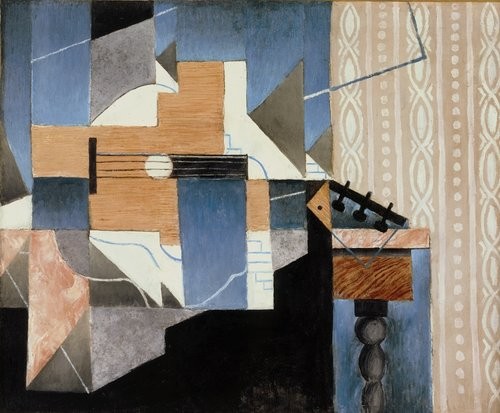Cubism and its Context in the Telefónica Collections
05 Feb - 26 Sep 2010
CUBISM AND ITS CONTEXT IN THE TELEFÓNICA COLLECTIONS
Until the 26th of September
After its presentation in Brussels, the exhibition Cubism and its Context in the Telefónica Collections opens at the Lehmbruck Museum in Duisburg, Germany, to coincide with the term of the Ruhr region as a 2010 European Capital of Culture. The exhibition, which has toured various Spanish and Latin American museums, can be seen in Duisburg until the 26th of September. On this occasion and for the first time the 44 pieces comprising the exhibition, which includes works by Juan Gris, Albert Gleizes, Jean Metzinger, André Lhote, María Blanchard, Joaquín Torres-García and Rafael Barradas amongst others, will be shown in dialogue with objects from another collection - 10 cubist sculptures from the Lehmbruck Museum collection of artists such as Picasso, Julio González, Gargallo, Lipchitz, Laurens and Archipenko.
The exhibition Cubism and its Context takes the works of Juan Gris as its starting point. When the artist was still relatively unknown, Telefónica collected his works and revealed him as one of the great masters of the Modernist Movement. Going further than the work done by Picasso and Braque, it was through the work of Gris that Cubism was redifined, becoming a more diverse, lasting adn complex movement than is usually thought. The exhibition Cubism and its Context has been conceived using the work of Gris as a basis and proposes a reassessment of his relationship with three different parameters: the so-called Cubist school, the importance of Cubism on Latin American modernism and, thirdly, of the capacity of Cubism to spread and develop as a starting point for other tendencies and options in the Modernist Movement.
Together with the style of Cubism considered essential, there was another type: that of Juan Gris and of those who called themselves Cubists. This other cubism asserted the plasticity of colour, always focused on the qualities and suggestions of forms and, in spite of its eventual convergence with pure painting, it always considered that this new art form needed to convey figurative content. Among the pieces on display we can see works which are firmly ensconced in the canons of the Cubist school together with pieces which show the relationship shared by Cubist language with that of Futurism, modern classicism, geometric abstraction and the new figurative painting or Surrealism, and we can even find works which project signs of the cultural identity of the artists who created them. Within this exhibition, Cubist work can offer its own inimitable poetry or act as a reference point, although it can also resonate deeply or set itself up as an effective starting point for other possibilities in the plastic arts. In all the works on show, however, Cubism always presents itself as a creative endeavour able to overcome the passing of time, geography and intercontinental distances.
Until the 26th of September
After its presentation in Brussels, the exhibition Cubism and its Context in the Telefónica Collections opens at the Lehmbruck Museum in Duisburg, Germany, to coincide with the term of the Ruhr region as a 2010 European Capital of Culture. The exhibition, which has toured various Spanish and Latin American museums, can be seen in Duisburg until the 26th of September. On this occasion and for the first time the 44 pieces comprising the exhibition, which includes works by Juan Gris, Albert Gleizes, Jean Metzinger, André Lhote, María Blanchard, Joaquín Torres-García and Rafael Barradas amongst others, will be shown in dialogue with objects from another collection - 10 cubist sculptures from the Lehmbruck Museum collection of artists such as Picasso, Julio González, Gargallo, Lipchitz, Laurens and Archipenko.
The exhibition Cubism and its Context takes the works of Juan Gris as its starting point. When the artist was still relatively unknown, Telefónica collected his works and revealed him as one of the great masters of the Modernist Movement. Going further than the work done by Picasso and Braque, it was through the work of Gris that Cubism was redifined, becoming a more diverse, lasting adn complex movement than is usually thought. The exhibition Cubism and its Context has been conceived using the work of Gris as a basis and proposes a reassessment of his relationship with three different parameters: the so-called Cubist school, the importance of Cubism on Latin American modernism and, thirdly, of the capacity of Cubism to spread and develop as a starting point for other tendencies and options in the Modernist Movement.
Together with the style of Cubism considered essential, there was another type: that of Juan Gris and of those who called themselves Cubists. This other cubism asserted the plasticity of colour, always focused on the qualities and suggestions of forms and, in spite of its eventual convergence with pure painting, it always considered that this new art form needed to convey figurative content. Among the pieces on display we can see works which are firmly ensconced in the canons of the Cubist school together with pieces which show the relationship shared by Cubist language with that of Futurism, modern classicism, geometric abstraction and the new figurative painting or Surrealism, and we can even find works which project signs of the cultural identity of the artists who created them. Within this exhibition, Cubist work can offer its own inimitable poetry or act as a reference point, although it can also resonate deeply or set itself up as an effective starting point for other possibilities in the plastic arts. In all the works on show, however, Cubism always presents itself as a creative endeavour able to overcome the passing of time, geography and intercontinental distances.

